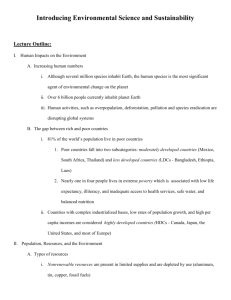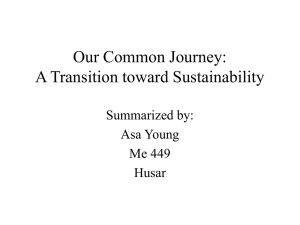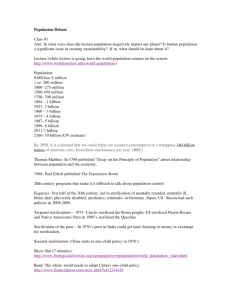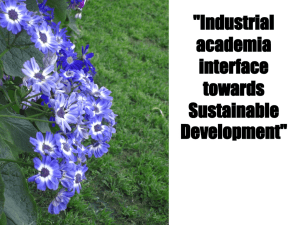sustainable - irosteveperry
advertisement
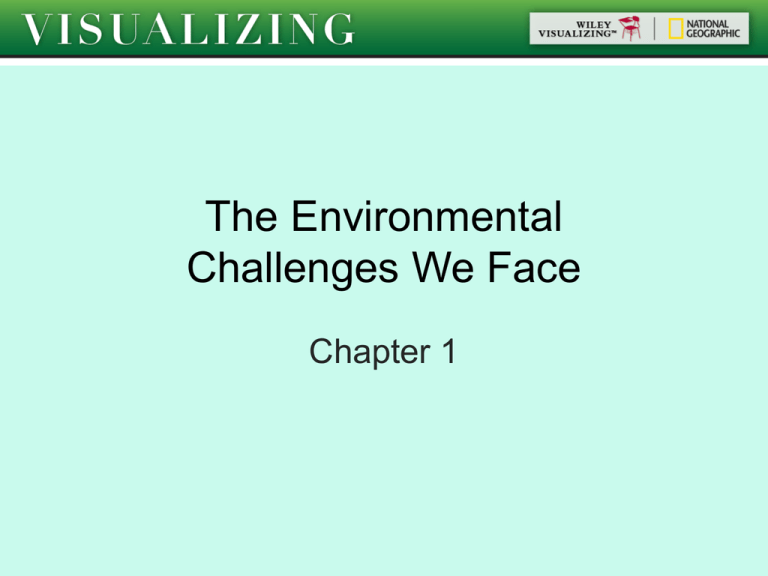
The Environmental Challenges We Face Chapter 1 A World in Crisis – Earth provides raw materials and energy for Life – Earth is approx 4.5 Billion years old • Modern humans appeared in Africa 195,000 yrs ago • Human populations have grown and expanded in range • Technology has allowed humans to live better (at least in developed nations) – Humans are the most significant agent of environmental change • • • • • Overpopulation Overconsumption of natural resources: topsoil, water, air Transforming and destroying natural environments Eradicating unique species Human-induced climate change A World in Crisis Human Impacts on the Environment • Learning Objectives: 1. Distinguish among highly developed countries, moderately developed countries, and less developed countries. 2. Relate human population size to natural resources and resource consumption. 3. Distinguish between people overpopulation and consumption overpopulation. 4. Describe the three factors that are most important in determining human impact on the environment. Human Impacts on the Environment • Overpopulation – Earth’s central environmental problem – Links all other environmental problems together – World’s population continues to grow and has grown very fast – 1960: 3 billion people – 1975: 4 billion – 1987: 5 billion – 2009: 6.8 billion • People consume food and water, use energy and raw materials and produce waste • Several more billion people will be added in the 21st century, even if we are proactive about population growth Linear vs. Exponential • Linear growth - a quantity increases by a constant amount per unit of time: 2, 4, 6, 8 or 1, 3, 5, 7, 9 & so on. • Exponential growth - a quantity increases by a fixed percentage of the whole in a given time: 1, 2, 4, 16 Environmental InSight Environmental InSight Human Impacts on the Environment • Poverty – A condition in which people are unable to meet their basic needs for food, clothing, shelter, education, or health. – One in four people lives in extreme poverty (less than $2/day): 3.3 billion people – Poverty is associated with short life expectancy, illiteracy, inadequate access to health services, safe water, balanced nutrition Human Impacts on the Environment Gap between Rich and Poor • Highly Developed Countries (Rich, HDCs) – Complex industrialized bases, low rates of population growth, and high per person incomes – 18 % of the world’s population – US, Canada, Japan, most of Europe Human Impacts on the Environment Gap between Rich and Poor – Poor Countries: 82% of world’s population – Moderately Developed (MDCs) • Medium levels of industrialization, lower per person incomes than highly developed countries, few opportunities for education and health care • Mexico, Turkey, South Africa, Thailand – Less Developed (LDCs) • Low levels of industrialization, high population growth, very high infant death rates, very low incomes, mostly agriculture based, cheap unskilled labor • Bangladesh, Mali, Ethiopia, Laos Human Impacts on the Environment Gap between Rich and Poor Human Impacts on the Environment Population, Resources, and the Environment • Developing countries – Rapid population growth is overwhelming – Natural resource depletion for survival (soils, forests, water) • Developed countries – Slower population growth – Higher rate of consumption beyond what’s necessary for survival (TV, computers, jet skis) Human Impacts on the Environment Types of Resources • Nonrenewable – Limited Supply: minerals, fossil fuels – Once they are gone, they are gone • Renewable/Potentially Renewable – Virtually unlimited: solar power, water, soil, forests – Replenished over short periods (days to decades) – Easy to overexploit nonrenewable • Soil, fresh water, clean air 3 Types of Resources 1. energy resources: coal, oil, natural gas, uranium, 2. metallic mineral resources iron, copper, aluminum, & 3. nonmetallic mineral resources salt, clay, sand, & phosphates • We convert these raw materials into many everyday items we use, & then we discard, reuse, or recycle them. Human Impacts on the Environment Resources and Population • Rapid population growth can cause resources to be overexploited – Critical in developing countries – Economic growth tied to natural resource exploitation – Choice between short term and long term • Poverty drives natural resource exploitation – Must use resources to survive, which degrades them and shuts down future opportunities for development Human Impacts on the Environment Population Size and Resource Consumption • A country is overpopulated if the demand on its resources results in damage to the environment. Can be overpopulated in 2 ways: • People Overpopulation – Consumption is high because there are too many people, even if individual consumption is low • Consumption Overpopulation – Consumption is high because each individual consumes too much, even if total population is low Human Impacts on the Environment Population Size and Resource Consumption • Highly developed countries have less than 20% of the world’s population, but consume: – 86% of aluminum – 76% of timber – 68% of energy – 61% of meat – 42% of fresh water • Also, produce 75% of waste and pollution Human Impacts on the Environment Human Impacts on the Environment Population Size and Resource Consumption • Ecological Footprints – The amount of land, fresh water, and ocean required on a continuous basis to supply a person with food, wood, energy, water, housing, clothing, transportation, and waste disposal. – Earth has 11.4 billion ha = 28.2 billion acres of productive land and water – 11.4/6.8 billion people = 1.8 ha (4.3 acres) – Currently, average ecological footprint is 2.7 ha (6.7 acres) – US footprint is 9.4 ha (23.3 acres) if everyone in the world had the same, we would need 4 Earths!!! Human Impacts on the Environment Human Impacts on the Environment Population, Consumption, and Environmental Impact • I=PxAxT • I: Environmental impact • P: Population (number of people) • A: Affluence per person (amt of resources) • T: Technology used to get resources • Interpret results with care! • Ultimate goal: make consumption sustainable Human Impacts on the Environment Global Climate Change 1. How do highly developed countries, moderately developed countries, and less developed countries differ regarding population growth and per person incomes? 2. How is human population growth related to natural resource depletion and environmental degradation? Sustainability and Earth’s Capacity to Support Humans • Learning Objectives: 1. Define environmental sustainability. 2. Identify human behaviors that threaten environmental sustainability Sustainability and Earth’s Capacity to Support Humans • Sustainability: – Ability to meet current needs without compromising the ability of future generations to meet their needs – Environment will function indefinitely – Based on: • • • • Effects of our actions on the environment Earth’s resources are finite Understanding impacts of consumption Shared responsibility for environmental sustainability Sustainability and Earth’s Capacity to Support Humans • We are not currently living sustainably: – Using nonrenewable resources as if they were renewable (e.g., fossil fuels) – Using renewable resources faster than nature can replenish them – Polluting the environment beyond capacity – Unchecked population growth, without regard to Earth’s finite resources and ability to deal with waste Environmental InSight The Tragedy of the Commons • One cause of environmental degradation is overuse of common-property resources, which are owned by none & available to all users free of charge. • Most are potentially renewable. • It happens because each user reasons, "If I don't use this resource, someone else will. The little bit I use or pollute is not enough to matter" Global Environmental Issues Global warming Deforestation Global Environmental Issues Threatened Oceans Desertification Global Environmental Issues Polar Ice caps Ozone Depletion Global Environmental Issues Environmental stress factor Sustainability and Earth’s Capacity to Support Humans • If we continue to live unsustainably, Earth may not recover • What changes are we willing to make? Focus on Sustainability Global Climate Change 1. What is environmental sustainability? 2. Which human behaviors threaten environmental sustainability? Environmental Science • Learning Objectives: 1. Define environmental science. 2. Outline the steps of the scientific method. Environmental Science • Interdisciplinary study of humanity’s relationship with other organisms and the physical environment – combines information from many fields: • biology, geology, geography, chemistry, economics, agriculture, law, politics, ethics, etc. – Ecology is a basic tool – Atmospheric Science – Environmental Chemistry – Geosciences Environmental Science • Goals – Establish general principles about how the natural world functions – Identifying, understanding, and solving problems that we have created – Not just ‘doom and gloom’ list of problems – Focus on solving problems Environmental Science • Science as a Process – Not just a collection of facts – Systematic way of studying the natural world – Requires collection of data through • Observation and experimentation – – – – – – Data must be analyzed and interpreted Not based on faith, emotion, intuition Requires repeatability and scrutiny No absolute certainty Requires reevaluation Ongoing process How We Handle Environmental Problems • Learning Objectives: 1. List and briefly describe the five stages of solving environmental problems. How We Handle Environmental Problems Global Climate Change 1. What are the five steps used to solve an environmental problem? Case Study The New Orleans Disaster: Hurricane Katrina – Storm damage was increased because of human alteration of the natural landscape: – Canals were built for navigationallowed salt water to intrude and kill marsh vegetation – Levees were built to stop floodingsediments did not build up to replenish the land – Settlements were built on drained wetlands – City was subsiding due to lack of bedrock Case Study

